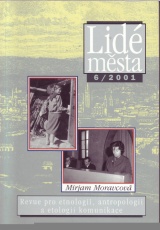Etnická polarizácia v podmienkach etnicky homogénneho mesta
DOI:
https://doi.org/10.14712/12128112.4136Abstrakt
This article summarizes problems of ethnic relationships among Bratislava (former Pressburg or Pozsony) residents during the 20th century. The lives of the citizens in this period were repeatedly significantly influenced by political twists changing the society. They affected also their personal integrity (and ethnic identity). The analysis is based on documents drawn from ethnological research and data from the archives and period newspapers. During the twentieth century the ethnic phenomenon now and again played a decisive role in shaping the town structure. lt seems that the presence of several ethnic groups softened the ideological polarization of the residents and enabled them more often to express tolerance in solving conflictual situations. On the contrary, when as a result of social processes one ethnic group gained hegemony due to the government pressure (on the verge of 19th and 20th centuries it was the Hungarian ethnicity, after 1938 Slovak population), the position of members of different nationalities deteriorated and intolerance increased. The tendency of the development was clear: the plural society (also due to forced migration) was changing (at least in the wiev of statistics) to ethnically homogenous one. From the middle of the 19th century Bratislava was an important centre of state institutions. It resulted not only in the increase of population, but also in expansion of administrative, industry and ideology. Bratislava became the destination of newcomers drawn by new job openings and cultural opportunities, but many of them were attracted by the vision of power and functions. Satisfying the demands of loyal supporters of each new system was inevitably cletrimental to the "former" ones, who had to leave their posts, gained mostly not so long ago (under the previous regime). Therefore, within each change, the representatives of the newly gained power perceived the often ethnically defined groups of Bratislava residents as their enemies. Their posts, flats, and properties were offered to those who were expected to support the new regime. Such lures and sanctions enforced not only the real movement of the population, bul also a "migration in the place", that is a declarative assimilation to ethnic, social or other politically preferred identity of the actually protected status. Ethnological research shows that such shifts were not rare. The multicultural character of Bratislava survived until World War II, although its ethnic character, at least statistically, has greatly changed. There were two main elements in forming the structure of Bratislava: natural attraction of the administralive, political and industrial centre and the pressure of governments, including principles of social engineering. All regimes and state forms, which followed until 1989, used such pressure (not with the same force). The arrival of members of certain ethnic groups , after 1948 social groups, were motivated by promises of privilege and their loyalty was expected. On the other hand, those, who were seen by the new power as its potential threat, left the town "wilingly" or more often by force. Such contrary movements were permanent, however, their intensity grew since the end of 1938, when on our territory totalitarian political culture was established with all its malpractice, only its types and manners changed. The climax of social engineering was in 1938-1953, during the fascist regime and outbreak of communist totality. We can speak about exchange of population. During one and half decade a forced departure of Czechs, deportation of Jews, expulsion of Germans, drift of a part of Hungarian population took place. Members of "bourgeoisie" had to leave the town because of so-called "Action B11". In the first place, they were representatives of town creating urban middle classes. As a natural result, all official statistical data since the beginning of the fifties have confirmed the domination of Slovak population. It might be useful to define this borderline also in terminology and from this date to distinguish between the pluralistic Pressburg and monoethnic Bratislava). According to all censuses conducted after World War II, over 90 % of the population declared Slovak nationality. In spite of this, in ethnically (seemingly) homogenous environment after the 1989 Velvet Revolution ethnic tensions increased again (especially against Romani people and Jews, to a lesser extent against Czechs).
Stahování
Publikováno
Jak citovat
Číslo
Sekce
Licence

Tato práce je licencována pod Mezinárodní licencí Creative Commons Attribution-NonCommercial-NoDerivatives 4.0.


